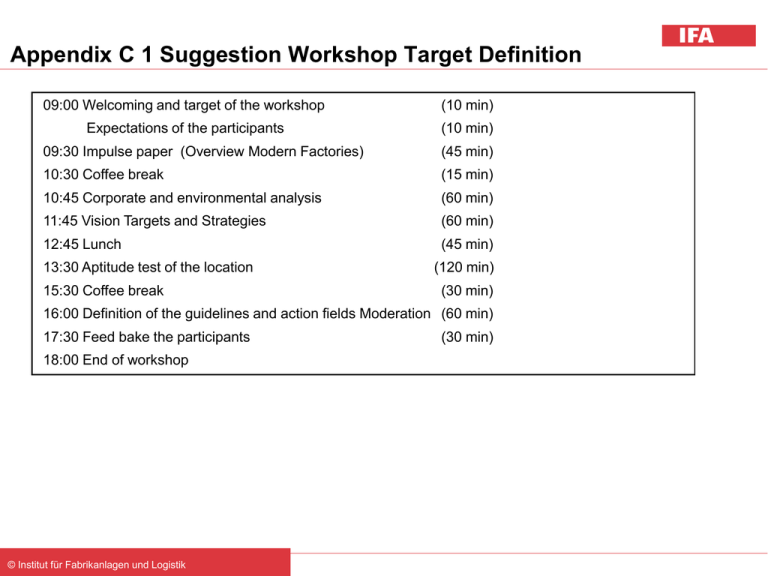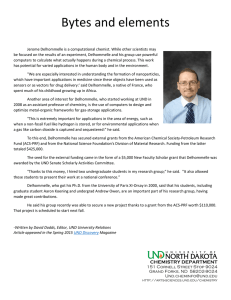Appendix C 1 Suggestion Workshop Target Definition
advertisement

Appendix C 1 Suggestion Workshop Target Definition 09:00 Welcoming and target of the workshop (10 min) Expectations of the participants (10 min) 09:30 Impulse paper (Overview Modern Factories) (45 min) 10:30 Coffee break (15 min) 10:45 Corporate and environmental analysis (60 min) 11:45 Vision Targets and Strategies (60 min) 12:45 Lunch (45 min) 13:30 Aptitude test of the location 15:30 Coffee break (120 min) (30 min) 16:00 Definition of the guidelines and action fields Moderation (60 min) 17:30 Feed bake the participants 18:00 End of workshop © Institut für Fabrikanlagen und Logistik (30 min) Corporate and Environmental Analysis © Institut für Fabrikanlagen und Logistik Fig. 1 Corporate and environmental analysis Market, Product, Competition 1. What / Where are your current markets? actual 2. What / Where are your markets to be in the future trends future? 3. Who are your present (key) customers? markets 1 2 customers 3 4 products 5 6 competitors 7 8 suppliers 9 10 4. What will be your future customers? 5. What products / services you offer today? 6. What products / services you offer in the future? 7. What are your present competitors? 8. What will be your future competitors? 11 9. Who are the current suppliers? 10. Who could in future be a supplier? 11. What influences, trends and developments are important for your current or foreseeable markets/ customers / suppliers and competitors? © Institut für Fabrikanlagen und Logistik Fig. 2 Corporate and environmental analysis Market, Product, Competition actual future trends markets customers products competitors suppliers © Institut für Fabrikanlagen und Logistik Fig. 3 Corporate and environmental analysis Success Factors of the Products 1. What distinguishes your products or services today compared to those of your competitors. (Features / Features / Features). Why customers buy from you and not from the competition? 2. What will your products or services distinguish in the future compared to those of your competitors? (characteristics / specials / features) Why should you and future customers do not buy from the competition? 3. What distinguishes the products or services compared to your competitors? Why customers buy from the competition? 4. What in future could distinguish the products or services of your competitors over yours so customers buy in the future from the competition? 5. What influence can be envisaged, which are currently or in the future for your products and services important? (materials, production technologies, customer requirements, quality, production costs, ousourcing etc.) today e3-Q future 1 2 5 competiti on 3 4 - Derivation of success factors (the importance of competitive factors for the business position) - Strategic success factors (these are important for the current success of the company) - Critical success factors (those correspond with an distinct weakness of the company) - Balanced competitive factors © Institut für Fabrikanlagen und Logistik Fig. 4 Corporate and environmental analysis Success Factors of the Products actual future Your company competition © Institut für Fabrikanlagen und Logistik Fig. 5 Corporate and environmental analysis Change Driver for production 1. What were the main drivers in the past which led to changes in your production? How frequently do they appear? 2. How did the change drivers affected the production concept, what measures have been taken? 3. What are the main drivers that will change in the future your production? With what frequency its occurance is expected? Change drivers / triggers in the past © Institut für Fabrikanlagen und Logistik product (Product Structure) quantity marketing action technologies markets (segmentation) delivery times 1 in the future expected Impact / measures 2 3 Fig. 6 Corporate and environmental analysis Change Driver for production change drivers / triggers impact / measures in the past in the future expected © Institut für Fabrikanlagen und Logistik Fig. 7 Vision, Targets und Strategies © Institut für Fabrikanlagen und Logistik Fig. 8 Key Questions From the brand and corporate vision the following questions are derived: What is the vision for the site from the perspective of stakeholders (owners, customers, employees, suppliers, investors and the region)? What are the meta targets for the site? (global, local) What is the strategy for the site? (global, local) © Institut für Fabrikanlagen und Logistik Fig. 9 Targets and Strategy Definition Corporate Vision, Targets and Strategy 1. What is the vision of your company? (Leader, definitely overnight, fast followers, best partner in ..., a leading innovator) 2. What are the meta targets of your company? (Sales, return, delivery times, market share, products, productivity, inventory turns, inventory reduction, system capacity, quality, versatility, volume / output, compared with competition, etc.) 3. Which strategy do you follow to achieve these goals? (Cost leadership, pioneering strategy, cooperation strategy, imitation strategy, niche strategy, technology leadership, zero-defect strategy, continuous improvement, process orientation, emergency strategies such as redundancy, scalability in small increments, modularity, cost advantages, production starts) © Institut für Fabrikanlagen und Logistik 1. Vision of brand and corporation ELV 2. Vision for the site 3. Meta targets of the Corporation for the site 4. Corporate Strategy for the site Bild 10 Targets and Strategy Definition Corporate Vision, Targets and Strategy Vision of brand and Corporation Vision for the site Meta targets of the Corporation for the site Corporate Strategy for the site © Institut für Fabrikanlagen und Logistik Bild 11 Planning Frame The planning framework determines which objects should be treated in the master plan and accordimng to which guidelines this should take place. On the basis of the defined objects, targets, strategy, strengths and weaknesses are observed and from that future requirements are generated. © Institut für Fabrikanlagen und Logistik Fig. 12 Suitability Analysis Site Sales Targets Strategy Weaknesses of the existing functions Strengths of the existing functions Requirements for future functions Restrictions © Institut für Fabrikanlagen und Logistik Bild 13 Suitability Analysis Site Production Targets Flexibilität, Prozesssicherheit, Neue Produktionstechnologien, Automatisierungsgrad, Sauberkeit, Wandlungsfähigkeit (alles auf Rädern), Qualität, transparenter Transport, Bestände Strategy Prozessorientierung, Modularisierung, Segmentierung, Automatisierung, Outsourcing, Wandlungsfähigkeit Weaknesses of the existing Production Strengths of the existing Production Requirements for the future production Restrictions © Institut für Fabrikanlagen und Logistik Maschinen alt/neu; Personalstamm; Technologieeinsatz Bild 14 Suitability Analysis Site Logistics Targets Delivery time, inventory level (production, storage), inventory turns, cycle time, utilization, delivery reliability, prority rules, no multiple handling, software (yes / no), cranes, forklifts, etc. (yes / no), material flow length, transport routes Strategy Control principle, stock strategy, procurement strategy, one-piece-flow, structuring principle, Central / Distributed Storage (good entry, manufacture, shipment) Weaknesses of the existing logistics Procurement, control, shipping macro-and micro-logistics Strengths of the existing logistics Delivery time, inventory level (production, storage), inventory turns, cycle time, utilization, delivery reliability, prority rules, no multiple handling, software (yes / no), cranes, forklifts, etc. (yes / no), material flow length, transport routes Requirements for the future logistics Restrictions © Institut für Fabrikanlagen und Logistik Bild 15 Suitability Analysis Site Staff Targets Strategy Weaknesses of the existing function Strengths of the existing function Requirements for the future function Restrictions © Institut für Fabrikanlagen und Logistik Bild 16 Suitability Analysis Site IT Targets Strategy Weaknesses of the existing function Strengths of the existing function Requirements for the future function Restrictions © Institut für Fabrikanlagen und Logistik Bild 17 Suitability Analysis Site Quality Targets Strategy Weaknesses of the existing function Strengths of the existing function Requirements for the future function Restrictions © Institut für Fabrikanlagen und Logistik Bild 18 Suitability Analysis Site Buildings, Site und Architecture Targets Strategy Weaknesses of the existing buildings/site Strengths of the existing buildings/site Requirements for the future buildings/site Restrictions © Institut für Fabrikanlagen und Logistik Bild 19 1.6 • Guide Lines for Factory Design • Working Packages • Evaluation Criteria © Institut für Fabrikanlagen und Logistik Bild 20 Guide Lines for the Development of the Site Here the main guide lines for the development of the site are set. Examples (without scoring or weighting) • Appearance adequate to the brand • Create an attractive working environment • Sustainable construction • Minimize energy consumption • Map the process chain • Communications fostering structures • Follow Lean management principles • Ensure changeability at all levels of the site (work place, cell, segment, building, location) © Institut für Fabrikanlagen und Logistik Bild 21 Working Packages • The work packages specify which specific sub-projects must be set up. • For this purpose, time and cost targets have to be defined. • From that follows a rough project plan with project organization and responsibilities © Institut für Fabrikanlagen und Logistik Bild 22 Design Fields Core Processes Process • Marketing • Sales • Research & Development • Production • Logistics © Institut für Fabrikanlagen und Logistik Sub Project Responsible Due Date Bild 23 Design Fields Support Processes Process • Human Resources • IT • Quality Management • Controlling & Finance © Institut für Fabrikanlagen und Logistik Sub Project Responsible Due Date Bild 24



